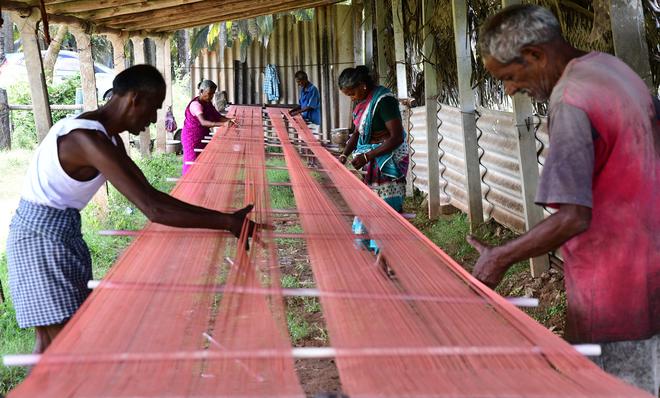THE FULL CONTEXT
Tamil Nadu, along with Kerala, is noted for its relatively inclusive development path. Both States have registered higher levels of development and lower levels of poverty compared to other major States. Unlike Kerala, Tamil Nadu’s development trajectory however draws upon a dynamic manufacturing and high-end services sector for its sustenance. As Kalaiyarasan and I argue in our book The Dravidian Model: Interpreting the Political Economy of Tamil Nadu, it is the State’s ability to combine dynamic industrialisation with effective investments in public health and education that has translated into better social and economic outcomes. Why is the process of industrialisation critical to the State’s developmental vision?
Modernisation for social justice
The Dravidian movement that shaped the political ethos in the State held that modernisation of the economic sphere is critical to secure social justice and address caste-based inequalities. The colonial regime fostered the emergence of new sites of power through expansion of the sphere of modern administration and economic activity that allowed caste elites to further strengthen their power by virtue of their access to education. Social justice therefore demanded democratising access to this sphere.
A caste-centric society also generated a range of economic unfreedoms for lower castes as it codified and structured a hierarchy of labourers with low caste labour confined to low status occupations requiring manual labour. Workers, as Periyar pointed out, were ‘born labourers’ with little scope for economic mobility. Addressing such unfreedoms therefore warranted a movement of lower castes into non-traditional sectors which can undermine such rigidities. Two sets of processes were therefore critical to this project. To enable labour to move out of inherited occupations, modern education had to be broad-based so as to help lower caste workers acquire skills that caste-based division of labour deny them. Investments in education along with incentives for the entry of children from lower caste households into education and affirmative action policies constitute one critical axis of intervention. Such interventions have to be backed by ensuring employment opportunities through an expansion of the modern economy. Industrialisation is therefore crucial to shift workers from traditional occupations, agriculture in particular, to the non-farm and urban economy. Interventions, therefore, sought to spur manufacturing along with democratisation of access to education and skills.
Employment and education
The State has indeed met with a degree of success in this regard. According to the State Human Development Report released in 2017, Tamil Nadu, along with Kerala, derives the least share of State income and employment from agriculture (both as wage labour and as cultivators) among major States. In fact, the latest Situation Assessment Survey of Agricultural Households and Land and Holdings of Households in Rural India, 2019 published by the National Statistics Office (NSO) indicates that only 26.3% of rural households in the State are agricultural households. These are households that derive a minimum of ₹4,000 per year from agricultural activities including livestock produce, and with at least one person reporting to be self-employed in agriculture either in principal or subsidiary status. Even by this generous definition, nearly 3/4 of rural households in Tamil Nadu are non-agricultural compared to the all-India average of just 53%. In fact, even among agricultural households in the State, a higher share of income from wage employment was derived from non-agriculture sectors than agriculture.
Three aspects of this process of diversification are noteworthy. Investments in education, technical education in particular, has been crucial. As per the All-India Survey of Higher Education for 2019-20, Gross Enrolment Ratio (GER) in tertiary education for those in the age group 18 to 23 was the highest in the State at 51.4%. The GER for Scheduled Caste (SC) youth was lower at 39.6%, but still the highest for SC youth among all major States. Tamil Nadu also has the highest number of students enrolled in polytechnics as well as the largest number of professional colleges in the country.
The manufacturing industry
On the demand side, the State stands third in terms of manufacturing output after Maharashtra and Gujarat, but is home to the largest number of factories and workers employed in organised manufacturing in the country. Manufacturing is relatively more labour intensive in Tamil Nadu. Textiles, garments, auto components and leather goods sectors dominate the manufacturing landscape of the State. Importantly, the share of wages in the Tamil Nadu manufacturing sector has been relatively better than in other major manufacturing States. As per data furnished by the Annual Survey of Industries, the share paid as wages and salaries in gross value added by organised manufacturing in the State was 19% in 2018-19. This share was only 11.2% and 13.6% in Gujarat and Maharashtra respectively.

This higher wage share is true for specific sectors within manufacturing. In the apparel making sector, which is labour intensive and spread across the three States, the share accruing to labour in Tamil Nadu’s garment industry is again higher than the other two States. While it is 32.5% and 26.2% in Gujarat and Maharashtra respectively in 2018-19, the share of wages and salaries to workers in Tamil Nadu was 38.2%.
Finally, Tamil Nadu is the only major State that has a strong manufacturing sector along with a vibrant knowledge-based services economy. Though Maharashtra continues to be a leading software services exporter because of its early mover advantage, its share has steadily declined whereas Tamil Nadu has increased and sustained its share of exports. The Chennai region has also emerged as the most important hub for the Software as a Service (SaaS) segment in the country. Apart from software services, the State is also a major healthcare service destination. These are clearly outcomes of building up human capabilities in the State.
Nevertheless, a few recent trends challenge the ability of such industrialisation to sustain the State’s inclusive development trajectory.
At a crossroad
Globally, and within India, there has been a steady decline in the ability of manufacturing to generate the quantum of jobs as it had in the past. More cars and two-wheelers, for example, are being produced by fewer workers. This decline in employment elasticity of manufacturing undermines the sector’s ability to act as a conduit for labour to exit from agriculture. Though manufacturing managed to fulfil this role until the last decades of the 20th century, Dani Rodrik, the Harvard-based economist points out that recent technological shifts and changes in trade regimes constrain this process in late developing economies like India. High levels of automation of routine and low-end tasks that earlier offered avenues to enter into the non-farm sector has adversely affected this process of mobility. Second, possibilities of import substitution, such as erecting trade barriers so as to promote domestic manufacture of imported goods, is a lot less possible under the current trade regime and hence difficult for new actors to enter.
A more worrying trend, currently, is about the quality of jobs in manufacturing.
Lack of quality employment in the manufacturing industry
In the past, there were vertical mobility paths within firms in the organised sector that allowed a semi-skilled worker entering as an apprentice in a factory to move on to become a supervisor and even attain managerial positions in the factory over time. Such mobility pathways are almost non-existent in the present manufacturing sector. Most firms recruit freshers from polytechnics and/or Industrial Training Institutes (ITIs) as apprentices. At the end of the mandatory period of training, they are rarely retained. Workers are expected to fend for themselves in the labour market based on the skills they have acquired. Heads of technical institutes like polytechnics and ITIs recall that leading firms in Chennai would offer regular employment to even 20% of such apprentices in the past. At present, they say that it is hard to see even three or four of them getting such long-term employment contracts. The possibility of a long-term career is even less in small and medium enterprises (SMEs) which have been adversely affected by a range of factors over the last quinquennial.
Apart from reduction in mobility pathways within firms, a major deterrent for workers to seek employment in manufacturing is the relatively lower wage rates. Depending on the firm, apprentices are paid anywhere between ₹8,000 to ₹12,000 in the Chennai and Coimbatore region which are major manufacturing locations in the State. This tends to be lower than what they can earn from say working as drivers or as delivery boys in the gig economy. The chances for wage levels to increase in the factories are not high in the short to medium term. Many also come from poor households, often belonging to the first generation of learners accessing higher education, with parents working in the informal economy. Any income or health shocks at the household level or disruptions in the familial architecture of social protection drive them to seek immediate employment that may often be outside manufacturing.
There are a couple of additional factors that deter youth from taking up manufacturing jobs. Those who migrate to Chennai or Coimbatore from rural areas for these jobs are burdened with considerable expenditure on housing and food. This constrains their ability to save. Further, youth seem to prefer the autonomy and flexibility of time that service sector jobs give them compared to the eight-hour work shifts in manufacturing and a strict work regimen.
Dependence on migrant labour
As a result, there are less takers for jobs in the manufacturing sector. In the Coimbatore region, known for its dynamic micro, small and medium enterprises, this inability to attract or retain labour in the factories has led to entrepreneurs expressing opinions against welfare provisioning to poor households as it undermines incentives for youth to work in their units. Many rely on inter-state migrant labour to address this gap as thin profit margins and new vulnerabilities deter them from improving the terms of employment. This preference for migrant labour is translating into a nativist demand to employ only in-State labour among some political quarters. Heads of technical institutes do concur that many students do not continue in manufacturing jobs or use their skill sets acquired in these educational institutions. Thus, investments in education are not translating adequately into gainful employment for large sections of youth as the manufacturing sector is not able to attract skilled labour.
Finally, efforts to move manufacturing to less industrialised regions in the State have met with mixed success. While there has been movement into the periphery of existing clusters, industrial parks set up in backward regions have not met with the desired success, especially in southern Tamil Nadu.
This raises the obvious question: Why are manufacturing firms not able to improve the quality of employment? To begin with, the MSME sector has been adversely affected by a range of factors that include macro-economic shocks, supply chain disruptions due to the pandemic and more recently high raw material and logistics costs. Second, at the entry level, firms do not require workers with advanced skill sets. Third, firms may not be able to pay competitive wages to in-State labour on account of lower productivity or lower returns especially in comparison to the middle and higher end services sector. Fourth, smaller manufacturers are of the opinion that given the higher returns to speculation in real estate markets, incentives to invest in manufacturing are lowered. Finally, firms also rate the skills imparted in technical institutes to be of inadequate quality.
Solutions and challenges
In an open economic environment, a policy focus on mere expansion of volume of output may not sustain manufacturing in the long run. Competition based primarily on low wage costs may lead to a situation where returns may continue to fall even as output and employment expand. To arrest the possibility of such ‘immiserising’ growth, it is important to ensure that firms diversify over time into segments of manufacturing where skill, quality, technology and design intensify. This will allow both firms and the State to appropriate more returns, and generate new employment and production linkages as it is difficult for firms with merely low-cost advantage to enter or compete. Appropriation of more value also enables producers to improve the quality of employment.
The fact that the wage share as well as educational attainments is higher in Tamil Nadu suggests an opportunity. The higher labour cost creates strong incentives for firms to utilise skilled labour in ways that can augment value addition. In other words, rather than focussing on cheap labour costs, incentives must be created for firms to deploy available skills to upgrade in product markets. In the absence of such upgrading, there is likely to be a strong downward pressure on wages or conditions of work. In terms of policy, this clearly requires a move away from merely providing financial incentives like low-cost land, power or tax concessions.
Strong institutions that can facilitate innovation in key sectors in collaboration with the private sector are therefore important. Institutions like the Central Leather Research Institute (CLRI) and the South India Textile Research Association (SITRA) are examples of such possibilities. Globally, the experiences of Hsinchu Science Park and the Industrial Technology Research Institute in Taiwan are worth taking on board. The fact that the State has competencies in both manufacturing and in knowledge-based services opens up more policy space for intervention.
Need for strengthening education ecosystem
Human capabilities are clearly critical for this process. Despite broad-basing of education, learning outcomes are far from satisfactory in the State. As per the data of the Annual Status of Education Report (ASER) on learning trends in the State for the period 2012-2018, only 46% of students in Class 5 in government schools could read a Class 2 textbook in 2018. Though there has been an increase in learning levels for each cohort over the years, the need to bridge learning outcomes continues to be strong. This is true of skill-based competencies built in tertiary education as well, according to industry insiders. Governments seek to address this by generating in-demand sector-specific skill sets through short term skilling programmes. Given the growing emphasis on such short-term skilling programmes, it may not be out of place to state that such investments may not translate into quality jobs.
Bhaskar Chakravorty and Arjun Bedi in their analysis of such a skilling and employment initiative in rural Bihar point out that though there is an increase in employment immediately after such skilling, the effects are completely nullified within two to six months after completion of training. One third of them dropped out of their jobs because salary levels were too low to offset their livelihood expenses. Studies in fact indicate that it is the quality of primary and higher levels of education that shape employment outcomes and labour productivity.
This also ties in with Dani Rodrik’s argument on the future world of work. The distinction between skill sets demanded in the manufacturing sector and knowledge-based sectors are blurring with the diffusion of digital technologies in product manufacture on the one hand and automation of routine tasks on the other. Rather than investments in sector-specific policies, he suggests a need for economy-wide investments in human capabilities. Sector-specific short-term skilling too may benefit when it is backed by an overhaul of pedagogies and curricula in the mainstream education system. Here again, the experiences of Singapore or Taiwan in building up skill ecosystems offer useful lessons.
Just industrialisation
The emphasis on building up of generic cognitive capabilities should not however be at the risk of undermining lower end manufacturing. At present, garment and leather goods production have been key to entry of less educated women into the modern workforce in the State. Policies that address the factors behind the inability of firms to move such sectors to lower cost locations within the State are critical to ensure spatial and social balance to the process of transformation. Spatial planning of economic diversification is going to be critical to ensure that land use is directed towards optimal employment.
Finally, though the state is known for its investments in public health and education, perceptions that these services are of insufficient quality have pushed sections of poor households to shift to the private sector, adding to household expenditure. This process has to be reversed to ensure that real wages of workers improve. Additional investments in social infrastructure near manufacturing clusters are therefore essential.
Social security provisioning in the State that has been crucial to address the vulnerabilities of workers also needs strengthening. This will insulate workers from economic shocks that firms may incur in the process of transition.
M. Vijayabaskar is with the Madras Institute of Development Studies and is also Member, State Planning Commission







